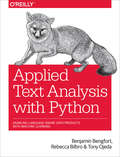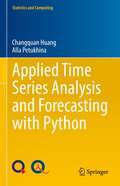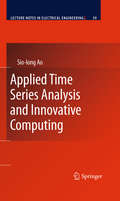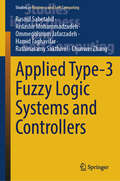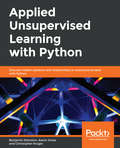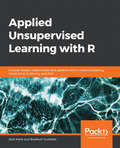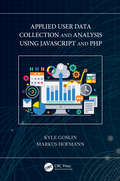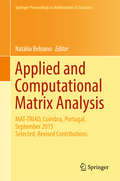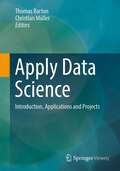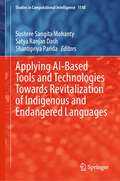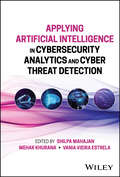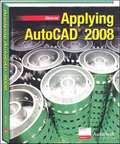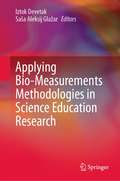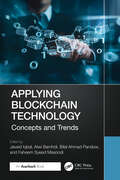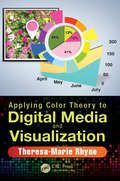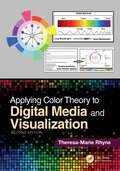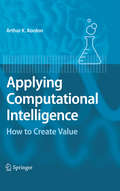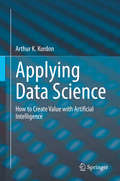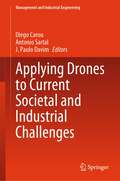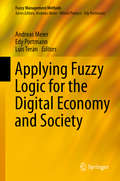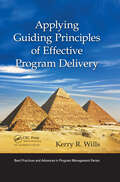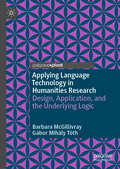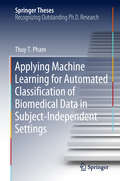- Table View
- List View
Applied Text Analysis with Python: Enabling Language-Aware Data Products with Machine Learning
by Tony Ojeda Benjamin Bengfort Rebecca BilbroFrom news and speeches to informal chatter on social media, natural language is one of the richest and most underutilized sources of data. Not only does it come in a constant stream, always changing and adapting in context; it also contains information that is not conveyed by traditional data sources. The key to unlocking natural language is through the creative application of text analytics. This practical book presents a data scientist’s approach to building language-aware products with applied machine learning.You’ll learn robust, repeatable, and scalable techniques for text analysis with Python, including contextual and linguistic feature engineering, vectorization, classification, topic modeling, entity resolution, graph analysis, and visual steering. By the end of the book, you’ll be equipped with practical methods to solve any number of complex real-world problems.Preprocess and vectorize text into high-dimensional feature representationsPerform document classification and topic modelingSteer the model selection process with visual diagnosticsExtract key phrases, named entities, and graph structures to reason about data in textBuild a dialog framework to enable chatbots and language-driven interactionUse Spark to scale processing power and neural networks to scale model complexity
Applied Time Series Analysis and Forecasting with Python (Statistics and Computing)
by Changquan Huang Alla PetukhinaThis textbook presents methods and techniques for time series analysis and forecasting and shows how to use Python to implement them and solve data science problems. It covers not only common statistical approaches and time series models, including ARMA, SARIMA, VAR, GARCH and state space and Markov switching models for (non)stationary, multivariate and financial time series, but also modern machine learning procedures and challenges for time series forecasting. Providing an organic combination of the principles of time series analysis and Python programming, it enables the reader to study methods and techniques and practice writing and running Python code at the same time. Its data-driven approach to analyzing and modeling time series data helps new learners to visualize and interpret both the raw data and its computed results. Primarily intended for students of statistics, economics and data science with an undergraduate knowledge of probability and statistics, the book will equally appeal to industry professionals in the fields of artificial intelligence and data science, and anyone interested in using Python to solve time series problems.
Applied Time Series Analysis and Innovative Computing (Lecture Notes In Electrical Engineering #59)
by Sio-Iong AoApplied Time Series Analysis and Innovative Computing contains the applied time series analysis and innovative computing paradigms, with frontier application studies for the time series problems based on the recent works at the Oxford University Computing Laboratory, University of Oxford, the University of Hong Kong, and the Chinese University of Hong Kong. The monograph was drafted when the author was a post-doctoral fellow in Harvard School of Engineering and Applied Sciences, Harvard University. It provides a systematic introduction to the use of innovative computing paradigms as an investigative tool for applications in time series analysis. Applied Time Series Analysis and Innovative Computing offers the state of art of tremendous advances in applied time series analysis and innovative computing paradigms and also serves as an excellent reference work for researchers and graduate students working on applied time series analysis and innovative computing paradigms.
Applied Type-3 Fuzzy Logic Systems and Controllers (Studies in Fuzziness and Soft Computing #417)
by Hamid Taghavifar Chunwei Zhang Rathinasamy Sakthivel Ardashir Mohammadzadeh Rasoul Sabetahd Ommegolsoum JafarzadehThis book provides the fundamental approaches to designing and using type-3 fuzzy systems in real-world applications. Basic Matlab codes are provided to use type-3 fuzzy systems in a straightforward scheme. The main differences between type-3 fuzzy systems and other types are analyzed and compared. The effectiveness of type-3 fuzzy systems is analyzed and studied in various applications, such as robotics, intelligent control systems, and data science.
Applied Unsupervised Learning with Python: Discover hidden patterns and relationships in unstructured data with Python
by Benjamin Johnston Aaron Jones Christopher KrugerDesign clever algorithms that can uncover interesting structures and hidden relationships in unstructured, unlabeled dataKey FeaturesLearn how to select the most suitable Python library to solve your problemCompare k-Nearest Neighbor (k-NN) and non-parametric methods and decide when to use themDelve into the applications of neural networks using real-world datasetsBook DescriptionUnsupervised learning is a useful and practical solution in situations where labeled data is not available. Applied Unsupervised Learning with Python guides you on the best practices for using unsupervised learning techniques in tandem with Python libraries and extracting meaningful information from unstructured data. The course begins by explaining how basic clustering works to find similar data points in a set. Once you are well versed with the k-means algorithm and how it operates, you’ll learn what dimensionality reduction is and where to apply it. As you progress, you’ll learn various neural network techniques and how they can improve your model. While studying the applications of unsupervised learning, you will also understand how to mine topics that are trending on Twitter and Facebook and build a news recommendation engine for users. You will complete the course by challenging yourself through various interesting activities such as performing a Market Basket Analysis and identifying relationships between different merchandises. By the end of this course, you will have the skills you need to confidently build your own models using Python.What you will learnUnderstand the basics and importance of clusteringBuild k-means, hierarchical, and DBSCAN clustering algorithms from scratch with built-in packagesExplore dimensionality reduction and its applicationsUse scikit-learn (sklearn) to implement and analyse principal component analysis (PCA)on the Iris datasetEmploy Keras to build autoencoder models for the CIFAR-10 datasetApply the Apriori algorithm with machine learning extensions (Mlxtend) to study transaction dataWho this book is forThis course is designed for developers, data scientists, and machine learning enthusiasts who are interested in unsupervised learning. Some familiarity with Python programming along with basic knowledge of mathematical concepts including exponents, square roots, means, and medians will be beneficial.
Applied Unsupervised Learning with R
by Bradford TuckfieldApplied Unsupervised Learning with R is designed for business professionals, who want to learn about methods to understand their data better, and developers, who have an interest in unsupervised learning. It'll help you to have basic, beginner-level familiarity with R, including how to open the R console, how to read data, and how to create a loop. To easily understand the concepts of this book, you should know basic mathematical concepts, such as exponents, square roots, means, and medians.
Applied User Data Collection and Analysis Using JavaScript and PHP
by Markus Hofmann Kyle GoslinApplied User Data Collection and Analysis Using JavaScript and PHP is designed to provide the technical skills and competency to gather a wide range of user data from web applications in both active and passive methods. This is done by providing the reader with real-world examples of how a variety of different JavaScript- and PHP-based libraries can be used to gather data using custom feedback forms and embedded data gathering tools. Once data has been gathered, this book explores the process of working with numerical data, text analysis, visualization approaches, statistics, and rolling out developed applications to both data analysts and users alike.Using the collected data, this book aims to provide a deeper understanding of user behavior and interests, allowing application developers to further enhance web-application development. Key Features: Complete real-world examples of gathering data from users and web environments Offers readers the fundamentals of text analysis using JavaScript and PHP Allows the user to understand and harness JavaScript data-visualization tools Integration of new and existing data sources into a single, bespoke web-based analysis environment
Applied and Computational Mathematics: ICoMPAC 2023, Sukolilo, Indonesia, September 30 (Springer Proceedings in Mathematics & Statistics #455)
by Dieky Adzkiya Kistosil FahimThis book collects selected, peer-reviewed research presented at the 8th International Conference on Mathematics: Pure, Applied, and Computation, held in Lombok, Indonesia, on 30 September 2023. Organised into three parts—Part I: Control Systems, Mathematical Simulation and Modeling; Part II: Formal Methods and Data Science; Part III: Graph Theory and Analysis—the book contains 29 peer-reviewed chapters. Ranging from theoretical to applied results, the book addresses the mathematical models for several phenomena such as investment behavior, unmanned surface vehicles and electronic medical records. It also highlights the progress in the use of satisfiability methods and tools to solve puzzle and pencil games. It showcases how mathematics is used to solve real-world problems.
Applied and Computational Matrix Analysis: MAT-TRIAD, Coimbra, Portugal, September 2015 Selected, Revised Contributions (Springer Proceedings in Mathematics & Statistics #192)
by Natália BebianoThis volume presents recent advances in the field of matrix analysis based on contributions at the MAT-TRIAD 2015 conference. Topics covered include interval linear algebra and computational complexity, Birkhoff polynomial basis, tensors, graphs, linear pencils, K-theory and statistic inference, showing the ubiquity of matrices in different mathematical areas. With a particular focus on matrix and operator theory, statistical models and computation, the International Conference on Matrix Analysis and its Applications 2015, held in Coimbra, Portugal, was the sixth in a series of conferences. Applied and Computational Matrix Analysis will appeal to graduate students and researchers in theoretical and applied mathematics, physics and engineering who are seeking an overview of recent problems and methods in matrix analysis.
Apply Data Science: Introduction, Applications and Projects
by Thomas Barton Christian MüllerThis book offers an introduction to the topic of data science based on the visual processing of data. It deals with ethical considerations in the digital transformation and presents a process framework for the evaluation of technologies. It also explains special features and findings on the failure of data science projects and presents recommendation systems in consideration of current developments. Machine learning functionality in business analytics tools is compared and the use of a process model for data science is shown.The integration of renewable energies using the example of photovoltaic systems, more efficient use of thermal energy, scientific literature evaluation, customer satisfaction in the automotive industry and a framework for the analysis of vehicle data serve as application examples for the concrete use of data science. The book offers important information that is just as relevant for practitioners as for students and teachers.
Applying AI-Based Tools and Technologies Towards Revitalization of Indigenous and Endangered Languages (Studies in Computational Intelligence #1148)
by Satya Ranjan Dash Shantipriya Parida Sushree Sangita MohantyThis book emphasises the need for language resource development and its impact on society. It covers latest AI based tools and techniques used to preserve indigenous and endangered languages. The book also highlights latest AI based technologies such as Generative Pre-trained Transformer (GPT) towards endangered language preservation. It discusses morphology analysis, translation support and shallow parsing of various tribal languages of India and abroad. This book tries to answer how digital technologies can make language revitalization accessible to future generations.
Applying Artificial Intelligence in Cybersecurity Analytics and Cyber Threat Detection
by Vania Vieira Estrela Mehak Khurana Shilpa MahajanAPPLYING ARTIFICIAL INTELLIGENCE IN CYBERSECURITY ANALYTICS AND CYBER THREAT DETECTION Comprehensive resource providing strategic defense mechanisms for malware, handling cybercrime, and identifying loopholes using artificial intelligence (AI) and machine learning (ML) Applying Artificial Intelligence in Cybersecurity Analytics and Cyber Threat Detection is a comprehensive look at state-of-the-art theory and practical guidelines pertaining to the subject, showcasing recent innovations, emerging trends, and concerns as well as applied challenges encountered, and solutions adopted in the fields of cybersecurity using analytics and machine learning. The text clearly explains theoretical aspects, framework, system architecture, analysis and design, implementation, validation, and tools and techniques of data science and machine learning to detect and prevent cyber threats. Using AI and ML approaches, the book offers strategic defense mechanisms for addressing malware, cybercrime, and system vulnerabilities. It also provides tools and techniques that can be applied by professional analysts to safely analyze, debug, and disassemble any malicious software they encounter. With contributions from qualified authors with significant experience in the field, Applying Artificial Intelligence in Cybersecurity Analytics and Cyber Threat Detection explores topics such as: Cybersecurity tools originating from computational statistics literature and pure mathematics, such as nonparametric probability density estimation, graph-based manifold learning, and topological data analysisApplications of AI to penetration testing, malware, data privacy, intrusion detection system (IDS), and social engineeringHow AI automation addresses various security challenges in daily workflows and how to perform automated analyses to proactively mitigate threatsOffensive technologies grouped together and analyzed at a higher level from both an offensive and defensive standpoint Providing detailed coverage of a rapidly expanding field, Applying Artificial Intelligence in Cybersecurity Analytics and Cyber Threat Detection is an essential resource for a wide variety of researchers, scientists, and professionals involved in fields that intersect with cybersecurity, artificial intelligence, and machine learning.
Applying AutoCad 2008
by Terry T. WohlersApplying AutoCAD 2008introduces new features and enhancements to existing capabilities. What's New in 2008? * A new default workspace called 2DDrafting & Annotationhas been added. * The new 2D Drafting and Annotation workspace employs a new Dashboard containing panels and toolbars for drawing and dimensioning in two dimensions, while new panels and features improve the Dashboard for the 3D Modeling workspace. * New dimensioning capabilities are introduced, including a new Multileader tool and easy alignment and spacing control of dimension lines. * New commands and features to control drawing annotations are added to simplify and improve Multiline text, text styles, tables, and the creation of bill of materials.
Applying Bio-Measurements Methodologies in Science Education Research
by Iztok Devetak Saša Aleksij GlažarThis book illustrates the problems of using eye tracking technology and other bio-measurements in science education research. It examines the application of bio-measurements in researching cognitive processes, motivation for learning science concepts, and solving science problems. Most chapters of this book use the eye-tracking method, which enables following the focus of the students’ attention and drawing conclusions about the strategies they used to solve the problem. This book consists of a total of fifteen chapters. Authors from eight countries emphasise the same trends despite their cultural and educational differences. The book begins with general chapters describing cognitive processes and how these processes are measured using eye-tracking methods and other psychophysiology parameters and motivation. Finally, the book concludes the chapters presenting studies in specific scientific fields from chemistry, biology, physics and geology.
Applying Blockchain Technology: Concepts and Trends
by Javaid Iqbal Faheem Syeed Masoodi Alwi M. Bamhdi Bilal Ahmad PandowBlockchain technology has the potential to revolutionize the way to conduct transactions and share information. It is having a significant impact on a wide range of industries. Applying Blockchain Technology: Concepts and Trends is an in-depth guide exploring the world of blockchain technology. Beginning with an introduction to concepts related to blockchain and its application, the book delves into the benefits and challenges of using blockchain in various industries, including healthcare, finance, real estate, voting, and supply chain management. It discusses potential ethical considerations associated with blockchain technology and how to design and implement blockchain solutions ethically. The book covers practical applications of blockchain in different industries, as well as its potential for use with IoT, smart grids, and cloud computing. Moreover, the book provides an in-depth discussion on the implications of blockchain on the financial system, as well as the potential of blockchain to disrupt the traditional ways of conducting business. It also covers the regulatory landscape of blockchain, its impact on privacy and data protection, and the future of blockchain technology. Highlights include: Blockchain and the future of accountancy; Enhancing data storage and security through blockchain technology; AI and blockchain innovation in supply chain performance; Blockchain-based secure data storage. The practical examples and case studies in the book are suitable for students, professionals, and researchers interested in learning about the latest trends in blockchain technology. This cutting-edge and far-ranging guide provides a deep look at blockchain technology and its applications that will revolutionize many industries.
Applying Color Theory to Digital Media and Visualization
by Theresa-Marie RhyneThis book provides an overview of the application of color theory concepts to digital media and visualization. It highlights specific color concepts like color harmony and shows how to apply the concept with case study examples and usage of actual online and mobile color tools. Color deficiencies are reviewed and discussed are color tools for examining how a specific color map design will look to someone with the deficiency. Other books on color examine artists' use of color, color management, or color science. This book applies fundamental color concepts to digital media and visualization solutions. It is intended for digital media and visualization content creators and developers. Presents Color Theory Concepts that can be applied to digital media and visualization problems over and over again Offers Comprehensive Review of the Historical Progression of Color Models Demonstrates actual case study implementations of color analyses tools Provides overview of Color Theory and Harmony Analytics in terms of online and mobile analysis tools Teaches the color theory language to use in interacting with color management professionals
Applying Color Theory to Digital Media and Visualization
by Theresa-Marie RhyneApplying Color Theory to Digital Media and Visualization provides an overview of the application of color theory concepts to digital media and visualization. It highlights specific color concepts such as color harmony and data color schemes. Examples of generative AI solutions for color scheme suggestion are provided. The usage of these concepts is shown with actual online and mobile tools. Color deficiencies are reviewed, and color tools for examining how a specific color map design will look to someone with the deficiency are discussed. A five-stage colorization process is defined and applied to case study examples.Features: Presents color theory and data color concepts that can be applied to digital media and visualization problems over and over again Offers a comprehensive review of the historical progression of color models Demonstrates actual case study implementations of color analyses tools Provides overview of color theory and harmony analytics in terms of online and mobile analysis tools Teaches the color theory language to use in interacting with color management professionals Unlike many books on color, which examine artists’ use of color, color management or color science, this book applies fundamental color concepts to digital media and visualization solutions, and the new edition includes generative AI solutions for color suggestion. This is the ideal book for digital media and visualization content creators and developers.
Applying Computational Intelligence: How to Create Value
by Arthur KordonThe flow of academic ideas in the area of computational intelligence is impacting industrial practice at considerable speed. Practitioners face the challenge of tracking, understanding and applying the latest techniques, which often prove their value even before the underlying theories are fully understood. This book offers realistic guidelines on creating value from the application of computational intelligence methods. In Part I, the author offers simple explanations of the key computational intelligence technologies: fuzzy logic, neural networks, support vector machines, evolutionary computation, swarm intelligence, and intelligent agents. In Part II, he defines the typical business environment and analyzes the competitive advantages these techniques offer. In Part III, he introduces a methodology for effective real-world application of computational intelligence while minimizing development cost, and he outlines the critical, underestimated technology marketing efforts required. The methodology can improve the existing capabilities of Six Sigma, one of the most popular work processes in industry. Finally, in Part IV the author looks to technologies still in the research domain, such as perception-based computing, artificial immune systems, and systems with evolved structure, and he examines the future for computational intelligence applications while taking into account projected industrial needs. The author adopts a light tone in the book, visualizes many of the techniques and ideas, and supports the text with notes from successful implementations. The book is ideal for engineers implementing these techniques in the real world, managers charged with creating value and reducing costs in the related industries, and scientists in computational intelligence looking towards the application of their research.
Applying Data Science: How to Create Value with Artificial Intelligence
by Arthur K. KordonThis book offers practical guidelines on creating value from the application of data science based on selected artificial intelligence methods. In Part I, the author introduces a problem-driven approach to implementing AI-based data science and offers practical explanations of key technologies: machine learning, deep learning, decision trees and random forests, evolutionary computation, swarm intelligence, and intelligent agents. In Part II, he describes the main steps in creating AI-based data science solutions for business problems, including problem knowledge acquisition, data preparation, data analysis, model development, and model deployment lifecycle. Finally, in Part III the author illustrates the power of AI-based data science with successful applications in manufacturing and business. He also shows how to introduce this technology in a business setting and guides the reader on how to build the appropriate infrastructure and develop the required skillsets. The book is ideal for data scientists who will implement the proposed methodology and techniques in their projects. It is also intended to help business leaders and entrepreneurs who want to create competitive advantage by using AI-based data science, as well as academics and students looking for an industrial view of this discipline.
Applying Drones to Current Societal and Industrial Challenges (Management and Industrial Engineering)
by J. Paulo Davim Diego Carou Antonio SartalThis book explores drone applications and the cutting-edge technologies that drive their functionality. From transforming everyday challenges like traffic congestion to enhancing efficiency in fields such as search and rescue operations, protection of critical infrastructure, and medicine, the book explores how drones serve as powerful allies to address diverse human needs. The chapters not only showcase the applications of drone technology but also shed light on how these vehicles can revolutionize commonplace tasks, such as delivering packages with unprecedented efficiency. The book also explores technological intricacies, regulatory considerations, and the evolving demands of today's consumers. By providing a holistic view, it equips readers with a deep understanding of the multifaceted landscape surrounding drone technology.
Applying E-Commerce in Business
by Dr Rana TassabehjiThis book provides an understanding of e-commerce by deconstructing it into its main constituents and explaining how they fit together. The objective is to introduce some consistency to the often contradictory views about e-commerce, bringing together different academic and management theories and frameworks into a coherent whole. It is written with a European perspective with examples that are drawn from around the globe, consistent with the nature of e-commerce. Visit the companion website An companion web site with links to exercises, further reading sections and teaching materials is available at www.tassabehji.co.uk This textbook gives an overview of e-commerce, relevant issues and frameworks. It looks at the foundations on which e-commerce is built - the technology. Managers and students of management must have an understanding of the infrastructure and inextricable linkages between processes and technology in a 21st century business. It is no longer acceptable or good business practice for technology to be the sole responsibility of IT departments. The book then goes on to examine businesses that have been built on these technology foundations. It explains the concept of the business model, the `dot com' phenomenon and frameworks that have emerged as a result. It also outlines the legal and ethical implications for an e-business. It outlines the academic debate about the impact of e-commerce on economics and management thinking. It concludes with a glance to the future, exploring the potential new wave of technology. This textbook will be essential for undergraduate and post graduate students. It is a user-friendly text with case studies, and learning objectives to guide the student and lecturers. A companion website will accompany the text including cases, student activities, PowerPoint slides, notes and articles in support of the book. It will also give lecturers direct access to the author. It will provide students with the skills to be able to converse knowledgeably with IT managers and be able to ask the right questions in order to make a decision about IT.
Applying Fuzzy Logic for the Digital Economy and Society (Fuzzy Management Methods)
by Edy Portmann Andreas Meier Luis TeránThis edited book presents the state-of-the-art of applying fuzzy logic to managerial decision-making processes in areas such as fuzzy-based portfolio management, recommender systems, performance assessment and risk analysis, among others. Presenting the latest research, with a strong focus on applications and case studies, it is a valuable resource for researchers, practitioners, project leaders and managers wanting to apply or improve their fuzzy-based skills.
Applying Guiding Principles of Effective Program Delivery
by Kerry R. WillsWhile today's programs continue to grow in size and complexity, their success rates remain low. To manage programs effectively in this environment, project managers and program managers must take a consultative approach that applies a core set of guiding principles across every function of the program. This book explains what it means to take a consultative approach. Instead of focusing on specific program management techniques, it covers the guiding principles required to make those techniques effective-making it applicable to any program in any industry.
Applying Language Technology in Humanities Research: Design, Application, and the Underlying Logic
by Barbara McGillivray Gábor Mihály TóthThis book presents established and state-of-the-art methods in Language Technology (including text mining, corpus linguistics, computational linguistics, and natural language processing), and demonstrates how they can be applied by humanities scholars working with textual data. The landscape of humanities research has recently changed thanks to the proliferation of big data and large textual collections such as Google Books, Early English Books Online, and Project Gutenberg. These resources have yet to be fully explored by new generations of scholars, and the authors argue that Language Technology has a key role to play in the exploration of large-scale textual data. The authors use a series of illustrative examples from various humanistic disciplines (mainly but not exclusively from History, Classics, and Literary Studies) to demonstrate basic and more complex use-case scenarios. This book will be useful to graduate students and researchers in humanistic disciplines working with textual data, including History, Modern Languages, Literary studies, Classics, and Linguistics. This is also a very useful book for anyone teaching or learning Digital Humanities and interested in the basic concepts from computational linguistics, corpus linguistics, and natural language processing.
Applying Machine Learning for Automated Classification of Biomedical Data in Subject-Independent Settings (Springer Theses)
by Thuy T. PhamThis book describes efforts to improve subject-independent automated classification techniques using a better feature extraction method and a more efficient model of classification. It evaluates three popular saliency criteria for feature selection, showing that they share common limitations, including time-consuming and subjective manual de-facto standard practice, and that existing automated efforts have been predominantly used for subject dependent setting. It then proposes a novel approach for anomaly detection, demonstrating its effectiveness and accuracy for automated classification of biomedical data, and arguing its applicability to a wider range of unsupervised machine learning applications in subject-independent settings.
